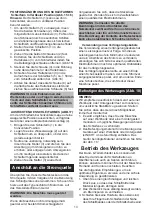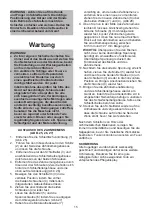
2
3
2
3
switch and remove plug from power source
outlet. Replace missing, damaged or failed
parts before resuming operation.
21. NEVER PULL THE POWER CORD out of
the receptacle by pulling on the cord. Keep
cords away from heat, oil and sharp edges.
22. HAVE AN ELECTRICIAN REPLACE
OR REPAIR damaged or worn cords
immediately.
23. NEVER use the belt / disc sander near
flammable liquids, vapors, or gases.
24. KEEP the belt / disc sander with proper
footing on a table to decrease noise and
vibration.
syMbols
V ………....volts A ……..…...........amperes
Hz… ….….hertz
W.............................watts
min …........minutes ~…. ....alternating current
h …............hours I ……….................... ON
O ….…......OFF
min
-1
…......revolutions per minute
Wear safety goggles
Wear ear protection
Wear a breathing mask
Read the manual
warning! to reduce the risk of injury,
user must read instruction manual.
environMental Protection
Waste electrical products should not
be disposed of with household waste.
Please recycle where facilities exist.Do
not dispose of electrical appliances as
unsorted municipal waste, use separate
collection facilities. Contact your local
government for information regarding the collection
systems available. If electrical appliances are
disposed of in landfills or dumps, hazardous
substances can leak into the groundwater and get
into the food chain, damaging your health and well-
being. When replacing old appliances with new
once, the retailer is legally obligated to take back
your old appliance for disposal at least for free of
charge.
Disposal of discarded material shall be in
accordance with local environmental regulations.
Motor .................................. 450 W, 230V ~ 50Hz
Belt ................................................100 x 914 mm
Disc ..................................................... Ø152 mm
No load speed .................................... 2875 min
-1
Work table ...................................... 225 x 149 mm
Net Weight ............................................... 22.5 kg
Table tilt ...................................................0
0
~ 45
0
Belt tilt ......................................................0
0
~ 90
0
Belt speed ............................................448 m/min
Belt dust chute ......Ø31.5 mm I.D. x Ø38 mm O.D.
Disc speed ...........................................2875 min
-1
Disc dust chute .....Ø31.5 mm I.D. x Ø36 mm O.D.
additional safety rules for
belt / Disc sander
1. This sander is designed to sand wood or
wood-like products only. Sanding or grinding
other materials could result in fire, injury or
damage to workpiece.
2. USE sander on horizontal surfaces only.
Operating the sander when mounted on non-
horizontal surfaces might result in motor
damage.
3. TO STOP it from tipping over or moving when
in use, the sander must be securely fastened
to a bench top or supporting surface.
4. PLACE the sander so neither the user nor
bystanders are forced to stand in line with
the abrasive belt or disc.
5. MAKE SURE the sanding belt is installed in
the correct direction. See directional arrow
on back of belt.
6. ALWAYS have the tracking adjusted properly
so the belt does not run off the pulleys.
7. DO NOT USE sanding belts or discs that are
damaged, torn or loose. Use only correct
size sanding belt and disc. Narrower belts
uncover parts that could trap fingers.
8. MAKE SURE there are no nails or foreign
objects in the part of the workpiece to be
sanded.
9. ALWAYS HOLD the workpiece firmly when
sanding. Keep hands away from sanding belt
or disc. Sand only one workpiece at a time.
10. ALWAYS SAND ON THE DOWNWARD
SIDE of the sanding disc when using the disc
sander. Sanding on the upward side of the
disc could cause the workpiece to fly out of
position, resulting in injury.
11. ALWAYS maintain a minimum clearance
of 1.59 mm or less between the table or
backstop and the sanding belt or disc.
12. DO NOT sand pieces of material that are too
small to be safely supported.
13. KEEP fingers away from where the belt goes
into the dust trap
14. WHEN sanding a large workpiece, provide
additional support at table height.
15. DO NOT sand with the workpiece
unsupported. Support the workpiece with the
backstop or table. Plan your work support.
16. NEVER USE ANOTHER PERSON as
additional support for a workpiece longer or
wider than the table.
17. ALWAYS remove scrap pieces and other
objects from the table, backstop or belt
before turning the sander ON.
18. NEVER perform layout, assembly or set-up
work on the table while the sander is operating.
19. NEVER use solvents to clean plastic parts.
Solvents could dissolve or otherwise damage
the material. Use only a soft damp cloth to
clean plastic parts.
20. SHOULD any part of your sander be missing,
damaged, or fail in any way, or any electrical
components fail to perform properly, shut off
Specifications
Содержание ENERGYSand-100
Страница 8: ...8 8 ...
Страница 24: ...24 24 Sommaire GB P 1 7 D P 9 15 F P 17 23 The original instruction manual is in English ...
Страница 29: ...29 29 Fig 27 Fig 25 Fig 26 4 3 9 4 8 7 6 5 2 3 1 2 1 Fig 28 Fig 29 ...
Страница 30: ...GB Combiné ponceur bandes et disque ENERGYSand 100 MANUEL D UTILISATION ...
Страница 33: ...33 33 Schematic MODEL ENERGYSand 100 ...



































